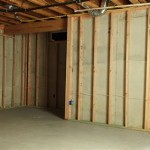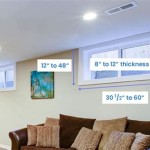What Color To Paint A Low Basement Ceiling
Basements, often relegated to storage or utility spaces, can be transformed into comfortable and inviting living areas. A significant factor in achieving this transformation is the ceiling's color. Low basement ceilings present unique challenges compared to standard height ceilings, demanding careful color selection to optimize the perceived height and overall spaciousness of the room. Choosing the right color can dramatically impact how the space feels, making it seem brighter, larger, and less claustrophobic.
The perceived height of a ceiling is heavily influenced by its color. Dark colors tend to absorb light, making the ceiling appear lower and closer. Conversely, light colors reflect light, creating an illusion of spaciousness and height. In a basement with a low ceiling, maximizing light reflection is paramount. Therefore, selecting the appropriate color palette becomes a critical decision that directly affects the comfort and functionality of the basement space.
The choice of paint color extends beyond merely aesthetics. It contributes to the overall ambiance of the basement, impacting mood and functionality. A well-chosen color can enhance natural light (if present), mitigate the lack of natural light (which is more often the case), and create a more welcoming atmosphere. This, in turn, will make the basement more enjoyable to use, whether it's a home theater, a playroom, a home office, or an additional living area.
Understanding the Impact of Light Reflection
Light Reflectance Value (LRV) is a crucial metric when selecting paint colors, particularly for low basement ceilings. LRV measures the percentage of light a color reflects, with a scale ranging from 0 to 100. A value of 0 indicates complete light absorption (black), while a value of 100 signifies complete light reflection (white). For low ceilings, colors with a high LRV are generally recommended. This is because they reflect more light back into the room, which visually expands the space and enhances the perception of height.
When considering light reflection, it’s not just about the specific color, but also the paint finish. Matte finishes absorb more light than glossier finishes. While matte finishes can be desirable for hiding imperfections, they're generally not the best option for low ceilings because they diminish the reflective properties of even light colors. Semi-gloss or eggshell finishes offer a better balance between hiding imperfections and reflecting light, making them more suitable for maximizing perceived height in a basement.
The surrounding elements in the basement also influence the effectiveness of light reflection. Dark furniture, flooring, and wall decor can counteract the benefits of a light-colored ceiling. To maximize the impact of the ceiling color, consider a cohesive design scheme that incorporates light and reflective elements throughout the space. This can include light-colored furniture, mirrors, and light-colored flooring to further enhance the sense of spaciousness.
Artificial lighting plays a significant role in augmenting the effect of a light-reflective ceiling. Recessed lighting, strategically placed, can bounce light off the ceiling and illuminate the room. This type of lighting helps to distribute light evenly, minimizing shadows and maximizing the perceived height. Conversely, poorly placed or inadequate lighting can diminish the benefits of a light-colored ceiling, making the space feel dim and cramped. Therefore, careful consideration should be given to the type and placement of lighting fixtures in conjunction with the ceiling color.
Optimal Color Choices for Low Basement Ceilings
White is the quintessential choice for low ceilings. Its high LRV maximizes light reflection, creating a bright and airy feel. Different shades of white exist, each with subtle variations in undertones. Pure white is a crisp and clean option, while off-white shades can add a touch of warmth. It's important to consider the existing color scheme of the basement when selecting a white hue to ensure it complements the other elements in the room.
Beyond white, pale shades of other colors can also be effective. Light gray, pale blue, and soft green can provide a subtle hint of color while still maintaining a high LRV. These colors can add a touch of personality to the basement without compromising the sense of spaciousness. When selecting these colors, it's crucial to choose shades that are significantly lighter than the wall color to create a visual distinction and further enhance the perceived height of the ceiling.
Pastel colors represent another suitable option for fostering a brighter and more open feel in basements with limited headroom. Pastel shades of pink, lavender, or yellow offer a gentle splash of color without overwhelming the space. Similar to light grays and blues, the key is to select a pastel shade that has a high LRV and complements the overall design aesthetic of the basement.
One strategy involves painting the ceiling the same color as the walls, or a shade slightly lighter. This technique, known as color drenching, blurs the lines between the walls and the ceiling, creating a sense of continuity and making the space feel larger. However, this technique is most effective when using light colors. Using darker colors for both the walls and ceiling can make the space feel enclosed and claustrophobic, which is the opposite of the desired effect for a low basement ceiling.
Addressing Specific Basement Ceiling Challenges
Unfinished basement ceilings often have exposed pipes, ductwork, and wiring which may need to be addressed before painting. One approach is to paint these elements the same color as the ceiling. This helps to camouflage them and create a more uniform and visually appealing look. This method is particularly effective when dealing with a limited budget or when concealing these elements is not feasible.
Another solution involves painting the exposed ductwork and pipes in a more decorative or intentional manner. This can be achieved by using metallic paint, contrasting colors, or even incorporating stenciled designs. However, this approach requires careful planning and execution to ensure it complements the overall design scheme and doesn't detract from the perceived height of the ceiling. A poorly executed decorative treatment can draw attention to the low ceiling and make the space feel even smaller.
If the budget allows, consider installing a drop ceiling to conceal the exposed elements. Drop ceilings create a smooth, uniform surface that can be easily painted in the desired color. This can be a more expensive option, but it provides a clean and polished look that can significantly improve the overall aesthetic of the basement. Drop ceilings also offer the benefit of improved sound insulation and the ability to easily access utilities in the ceiling space.
Mold and mildew are common concerns in basements due to high humidity levels. Before painting, it's crucial to address any existing mold or mildew issues to prevent them from recurring. This can involve cleaning the affected areas with a mold-killing solution and ensuring proper ventilation in the basement. Using a paint specifically formulated for basements, with mold and mildew resistance, is also highly recommended.
In conclusion, selecting the correct color to paint a low basement ceiling requires careful judgement of light conditions, existing features, and intended use of the space. Taking the time to consider these factors will ensure that the chosen color will enhance the basement's usability and aesthetic appeal.

Deciding What Color To Paint Basement Ceiling

Diy Basement Ceiling Ideas 6 Best Beautiful Budget Options This Life

Our Painted Basement Ceiling Without A Sprayer And The Perfect Black Paint This Diy Life

28 Low Basement Ceiling Ideas That Will Transform Your Space

15 Basement Ceiling Ideas To Inspire Your Space Bob Vila

28 Low Basement Ceiling Ideas That Will Transform Your Space

Unfinished Basement Ideas Low Ceiling Unfinishedbasementdecoratingideasonabudget Basementce Remodeling Painted

28 Low Basement Ceiling Ideas That Will Transform Your Space

17 Brilliant Ideas For Exposed Basement Ceilings Northern Feeling

Tales Of Painted Basement Ceilings And Pole Dancing Woes Beth Bryan







